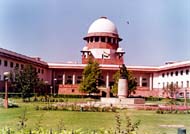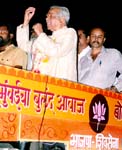Commentary/Venu Menon
Judicial activism has not lost its shine, but it will result in the devaluation of judicial authority
 There are no signs of let-up in the judiciary's pursuit of its
agenda of national reform. Its activist image is built on the
ruined reputations of the high and mighty, providing a form of
entertainment that rivals the best that cable television has to
offer.
There are no signs of let-up in the judiciary's pursuit of its
agenda of national reform. Its activist image is built on the
ruined reputations of the high and mighty, providing a form of
entertainment that rivals the best that cable television has to
offer.
But there is also a good deal of soul-searching about where all
this leads. The subordinate judiciary invites sermons on
judicial restraint by its reckless remarks against the political
class, and politicians have closed ranks and set about orchestrating
a backlash. Still, judicial activism has not lost its shine.
The identification of the judiciary as a countervailing moral force
set against a decadent political establishment has snowballed
into a national sentiment.
There are grounds for this glorification of the judiciary. The
Supreme Court converted its passive potential into kinetic energy
and stunned the nation by its resolve to stem the rot, and enforce
the rule of law without fear or favour. A procession of prominent
personalities passed before it shackled to the provisions of law.
It was the Supreme Court that shattered the myth of immunity that surrounded
the controversial tantrik Chandra Swami, and made him vulnerable to the processes
of justice. His political patron P V Narasimha Rao also came
under the court's scrutiny for his conduct as prime minister.
It was the Supreme Court's pressure on the country's premier investigating
agency that exposed the colossal politico-economic scam and etched
the word hawala in public consciousness.
Yet there is anxiety that the country is being run through court
decrees, that a compromised political executive has lost its moral
authority to govern and is yielding ground to an over-assertive
judiciary. Primarily, this is an anxiety that grips members of
the executive and the legislature charged with abdicating their
constitutional responsibility, and inviting judicial intervention
into their respective domains. The public applauds the court in
its activist role.
Constitutional purists worry that the delicate balance between
three branches of State has been upset, that an overzealous judiciary
imperils the scheme of the separation of powers. This could prove
to be true over the long term, but the crisis of credibility that
afflicts the executive and the legislature at this juncture makes
out a case in favour of the judiciary and its impetus for reform.
Aberrations by lower court functionaries cannot be an argument
against judicial intervention in the face of abuse or collapse
of executive authority.
Judges, it may be argued, do not hold elective office and to that
extent are free of the constraints and consequences that dog the
decisions of the executive. Therefore the judiciary is free of
the profit or political motive. In recent times both the executive
and legislature have been racked by partisan and mercenary
compulsions. The hawala investigation took on the appearance of
a crackdown on Narasimha Rao's political opponents. And the antics
of the Jharkhand Mukti Morcha MPs, who allegedly propped up the
Rao ministry during the 1993 confidence motion for a price, stigmatised
the legislature.
It was inevitable the judiciary would step in to fill the vacuum.
When it took over the hawala investigation and removed the CBI
from the administrative control of the prime minister's office,
the Supreme Court's aim was to restore credibility to the investigation
process. It was unprecedented that an investigating agency had
been told by the court not to take orders from the highest adminstrative
authority. A decision that has been instrumental for whatever progress made
so far in the case.
This kind of intervention projects the court as the strong arm
of the democratic process and an agent of systemic reform. It
is directly the result of a morally weak government conceding
ground to the judiciary.
The snag in this scenario is that the court is drawn into playing
the role of a surrogate government. In principle, executive authority
is usurped by judicial diktat. In practice, it will result in
the devaluation of judicial authority.
The court can offer correctives, but it cannot substitute the
functions of the government. It cannot play the role of political
decision maker. Judicial intervention can restore credibility to an investigation so that
the ends of justice are met. But it must not result in the diminution
of the exectuve as an institution. The separation of powers emphasises
separateness but not mutual exclusiveness.
Judicial activism ensures that the rule of law is upheld. It cannot
ensure that the government restores its credibility. That is the
dilemma of the moment.
It may be necessary for the judiciary to decelerate its programme
of reform. The Supreme Court has presided over a breathtaking
range of issues in fairly quick succession: It has busted the
multimillion hawala racket; it has humbled the seemingly invincible
Chandra Swami; it has pulled up the Election Commission; it has
ticked off the chiefs of investigating agencies; it has jailed
defiant bureaucrats; it has intervened in the Cauvery water dispute.
The list goes on.
The Supreme Court has gone beyond its traditional function of merely
interpreting the law. Its zeal for reform is likely to lead it
squarely towards the stereotype of a Constitutional policeman
wielding his truncheon with reckless abandon, venturing into areas
outside his beat.
The irony is that the court's forays into territory reserved for
the executive and legislature have met with no moral resistance,
simply because the moral collapse of these institutions is the
very reason that invties judicial intervention in the first place.
Still, there exists the lurking danger of judicial excess that
is likely to be committed because of unrestrained intervention
into the constitutional space of other institutions.
There is another problem. When executive decisions are subject
to scathing judicial review, executive authority is subtly undermined
and the court casts itself as a usurper of political authority.
When the judiciary handles politically sensitive issues, it may
sometimes unleash forces and events beyond its control.
 The Supreme Court has come dangerously close to doing this in two
specific instances. The court accepted the Ayodhya reference which
involved questions of archaeology and history (whether a temple
preceded the mosque at the diputed site) and after two years returned
the reference to the government without adjudicating it. It was
an exercise that lowered the stature of the judiciary. The court
was slow to recognise the political fallout of a vexed issue such
as Ayodhya.
The Supreme Court has come dangerously close to doing this in two
specific instances. The court accepted the Ayodhya reference which
involved questions of archaeology and history (whether a temple
preceded the mosque at the diputed site) and after two years returned
the reference to the government without adjudicating it. It was
an exercise that lowered the stature of the judiciary. The court
was slow to recognise the political fallout of a vexed issue such
as Ayodhya.
The same indiscretion is reflected in the apex court's pronouncements
on Hindutva in the Manohar Joshi election petition case which
legitimised the BJP use of Hindutva as a campaign plank. The judgment
is not vigilant to the subversive content of Hindutva as a political
slogan. It served as the BJP clarion call to mobilise the surging
mob that razed of Babri Masjid.
The question that needs to be asked of the judiciary is whether
it can confine itself to a purely legalistic and philosophical
examination of volatile and divisive issue such as Hindutva. The
Supreme Court appears to have adopted a potentially perilous course
in sanctifying the use of the slogan by political groups such
as the BJP and the Shiv Sena, whose threat perception is likely
to increase in the wake of the verdict.
It is incumbent on the judiciary to exercise caution when it scrutinises
political questions. Its verdicts must be unassailable. Most important,
they must not defy implementation. An order that is difficult
to execute subtracts from the majesty of the court. And when that
happens, the judiciary would lose its relevance as a repository
of public faith.
|





 There are no signs of let-up in the judiciary's pursuit of its
agenda of national reform. Its activist image is built on the
ruined reputations of the high and mighty, providing a form of
entertainment that rivals the best that cable television has to
offer.
There are no signs of let-up in the judiciary's pursuit of its
agenda of national reform. Its activist image is built on the
ruined reputations of the high and mighty, providing a form of
entertainment that rivals the best that cable television has to
offer.
 The Supreme Court has come dangerously close to doing this in two
specific instances. The court accepted the Ayodhya reference which
involved questions of archaeology and history (whether a temple
preceded the mosque at the diputed site) and after two years returned
the reference to the government without adjudicating it. It was
an exercise that lowered the stature of the judiciary. The court
was slow to recognise the political fallout of a vexed issue such
as Ayodhya.
The Supreme Court has come dangerously close to doing this in two
specific instances. The court accepted the Ayodhya reference which
involved questions of archaeology and history (whether a temple
preceded the mosque at the diputed site) and after two years returned
the reference to the government without adjudicating it. It was
an exercise that lowered the stature of the judiciary. The court
was slow to recognise the political fallout of a vexed issue such
as Ayodhya.